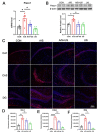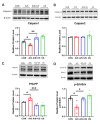Low-Intensity Pulsed Ultrasound Attenuates Postoperative Neurocognitive Impairment and Salvages Hippocampal Synaptogenesis in Aged Mice
- PMID: 37190622
- PMCID: PMC10137221
- DOI: 10.3390/brainsci13040657
Low-Intensity Pulsed Ultrasound Attenuates Postoperative Neurocognitive Impairment and Salvages Hippocampal Synaptogenesis in Aged Mice
Abstract
Postoperative neurocognitive impairment is an urgent problem with global aging accelerating. The prevention and treatment of postoperative neurocognitive impairment have been widely investigated but lack effective strategies. Low-intensity pulsed ultrasound (LIPUS), a non-invasive tool, has shown an effect on neuroprotection, but whether it could attenuate the postoperative neurocognitive impairment and the underlying mechanisms remains unknown. An experimental setup for LIPUS stimulation of the hippocampus was well established. A laparotomy model in aged mice was applied, and a Morris water maze was used to assess cognitive function. RT-qPCR and western blotting were used to detect levels of Piezo1, synapse-associated proteins in the hippocampus, respectively. Immunofluorescent staining was also used to determine the neural activation and Piezo1 expression. The results showed that LIPUS increased synapse-related proteins of the hippocampus and attenuated cognitive impairment in aged mice. Meanwhile, LIPUS suppressed the overexpression of Piezo1 in the hippocampus. We further found that LIPUS promoted Calpain1 activity and increased extracellular regulated protein kinases (Erk) phosphorylation. Our results suggested that LIPUS could improve cognitive impairment and increase hippocampal synaptogenesis through the Piezo1-mediated Calpain1/ Erk pathway. LIPUS could be used as an effective physical intervention to alleviate postoperative cognitive dysfunction in the aged population.
Keywords: Calpain1; Piezo1; delayed neurocognitive recovery (dNCR); low-intensity pulsed ultrasound (LIPUS); synaptogenesis.
Conflict of interest statement
The authors declare no conflict of interest.
Figures







Similar articles
-
Cholecystokinin octapeptide improves hippocampal glutamatergic synaptogenesis and postoperative cognition by inhibiting induction of A1 reactive astrocytes in aged mice.CNS Neurosci Ther. 2021 Nov;27(11):1374-1384. doi: 10.1111/cns.13718. Epub 2021 Aug 17. CNS Neurosci Ther. 2021. PMID: 34402181 Free PMC article.
-
Low-intensity pulsed ultrasound triggers a beneficial neuromodulation in dementia mice with chronic cerebral hypoperfusion via activation of hippocampal Fndc5/irisin signaling.J Transl Med. 2023 Feb 23;21(1):139. doi: 10.1186/s12967-022-03824-7. J Transl Med. 2023. PMID: 36823656 Free PMC article.
-
Low-intensity pulsed ultrasound attenuates cardiac inflammation of CVB3-induced viral myocarditis via regulation of caveolin-1 and MAPK pathways.J Cell Mol Med. 2019 Mar;23(3):1963-1975. doi: 10.1111/jcmm.14098. Epub 2018 Dec 27. J Cell Mol Med. 2019. PMID: 30592150 Free PMC article.
-
Review on experimental study and clinical application of low-intensity pulsed ultrasound in inflammation.Quant Imaging Med Surg. 2021 Jan;11(1):443-462. doi: 10.21037/qims-20-680. Quant Imaging Med Surg. 2021. PMID: 33392043 Free PMC article. Review.
-
Clinical applications of low-intensity pulsed ultrasound and its potential role in urology.Transl Androl Urol. 2016 Apr;5(2):255-66. doi: 10.21037/tau.2016.02.04. Transl Androl Urol. 2016. PMID: 27141455 Free PMC article. Review.
Cited by
-
Piezo1 Mediates Ultrasound-Stimulated Dopaminergic Neuron Protection via Synaptic Vesicle Recycling and Ferroptosis Inhibition.Neurosci Bull. 2025 May 29. doi: 10.1007/s12264-025-01420-5. Online ahead of print. Neurosci Bull. 2025. PMID: 40439849
-
Physical modulation of mesenchymal stem cell exosomes: A new perspective for regenerative medicine.Cell Prolif. 2024 Aug;57(8):e13630. doi: 10.1111/cpr.13630. Epub 2024 Mar 10. Cell Prolif. 2024. PMID: 38462759 Free PMC article. Review.
-
Low-intensity pulsed ultrasound stimulation (LIPUS) modulates microglial activation following intracortical microelectrode implantation.Nat Commun. 2024 Jun 29;15(1):5512. doi: 10.1038/s41467-024-49709-9. Nat Commun. 2024. PMID: 38951525 Free PMC article.
References
-
- Holmgaard F., Vedel A.G., Rasmussen L.S., Paulson O.B., Nilsson J.C., Ravn H.B. The association between postoperative cognitive dysfunction and cerebral oximetry during cardiac surgery: A secondary analysis of a randomised trial. Br. J. Anaesth. 2019;123:196–205. doi: 10.1016/j.bja.2019.03.045. - DOI - PMC - PubMed
-
- Mahanna-Gabrielli E., Schenning K.J., Eriksson L.I., Browndyke J.N., Wright C.B., Evered L., Scott D.A., Wang N.Y., Brown C.H., Oh E., et al. State of the clinical science of perioperative brain health: Report from the American Society of Anesthesiologists Brain Health Initiative Summit 2018. Br. J. Anaesth. 2019;123:464–478. doi: 10.1016/j.bja.2019.07.004. - DOI - PMC - PubMed
Grants and funding
LinkOut - more resources
Full Text Sources
Miscellaneous

